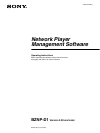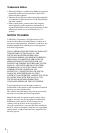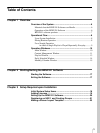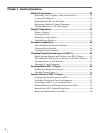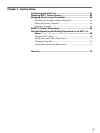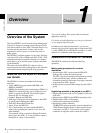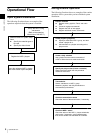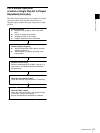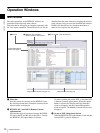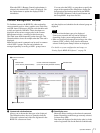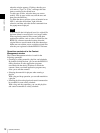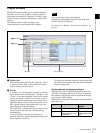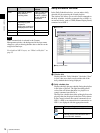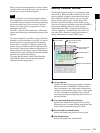
7
Overview of the System
Chapter 1 Overview
Creating playout schedule for an NSP-1
• Creating playlists (including specifying layout settings)
• Creating a daily schedule
Listing playlists and control commands
• Creating a periodic schedule
Specifying the period when the daily schedule is to be
used.
Distribution to an NSP-1
• Sending materials, playlists and schedules
• Sending text for overriding content currently being
played on the NSP-1.
• Checking transfer status
• Checking the NSP-1 status, playout schedules, and
results (by connecting to the NSP-1 via a network and
utilizing a web page)
In addition to the above operations, the BZNP-D1 software
also provides the settings for BZNP-D1 configurations.
On layouts and playlists
The BZNP-D1 software manages an NSP-1 so as to
display and play respective pieces of material, or a
combination of materials.
While editing a playlist, you can specify a combination of
materials and the position of each piece of material to be
displayed on a screen as “layout.”
Order or timing of the materials to be played or other time-
related settings will be defined in a “playlist.”
Unlike other authoring software, the BZNP-D1 software
manages materials separately, rather than combining them
onto a timeline to create a piece of video material, and then
sends them to the NSP-1. The NSP-1 plays the materials
automatically, according to a playlist, which also includes
layout information, and schedule data received together
with the materials.
This feature allows you to quickly replace some pieces of
graphics and text materials that are small in data size, or to
modify the position of video and/or text on the graphics
material, or produce new combinations of the materials
simply by sending a new playlist. The system enables you
to fully utilize your audio and visual contents for flexible
playout.
For details on layouts and playlists, see “What is a
Playlist?” on page 35.
On schedules
A “playlist” defines playout order and timing of materials
in a story, like a TV program.
In addition to a playlist, the BZNP-D1 software defines a
“daily schedule” and a “periodic schedule,” which are
grouped and referred to as a “schedule.”
A “daily schedule” defines the start and end times, in a
day, of each program (or playlist). A program will be
played repeatedly in the specified time.
A “periodic schedule” defines which daily schedule is to
be used for a specific day. You can create a daily schedule
and allocate it to each week of a month or to each month
easily.
For details on schedules, see “Daily Schedules and
Periodic Schedules” on page 45.
BZNP-D1 software products
The BZNP-D1 system includes the following types of
BZNP-D1 software products:
• BZNP-D1LE
Free software that manages only one NSP-1.
•BZNP-D1
A software license for managing up to ten NSP-1
players. You can increase the number of NSP-1 players
(up to 210) that the BZNP-D1 software can manage by
purchasing additional licenses.
•BZNP-DP10
A software license that adds ten more NSP-1 players to
be managed by the BZNP-D1 software.
•BZNP-DP50
A software license that adds 50 more NSP-1 players to
be managed by the BZNP-D1 software.
The products differ only in the number of NSP-1 players
each one can handle, and are identical in features and
operations.
For detailed operations in registering the licenses and
increasing the number of NSP-1 players to be managed,
see “Adding Licenses” on page 19.
Each software package or license can only be used on a
single PC. The product is offered subject to the supplied
license agreement displayed upon installation.
Note



